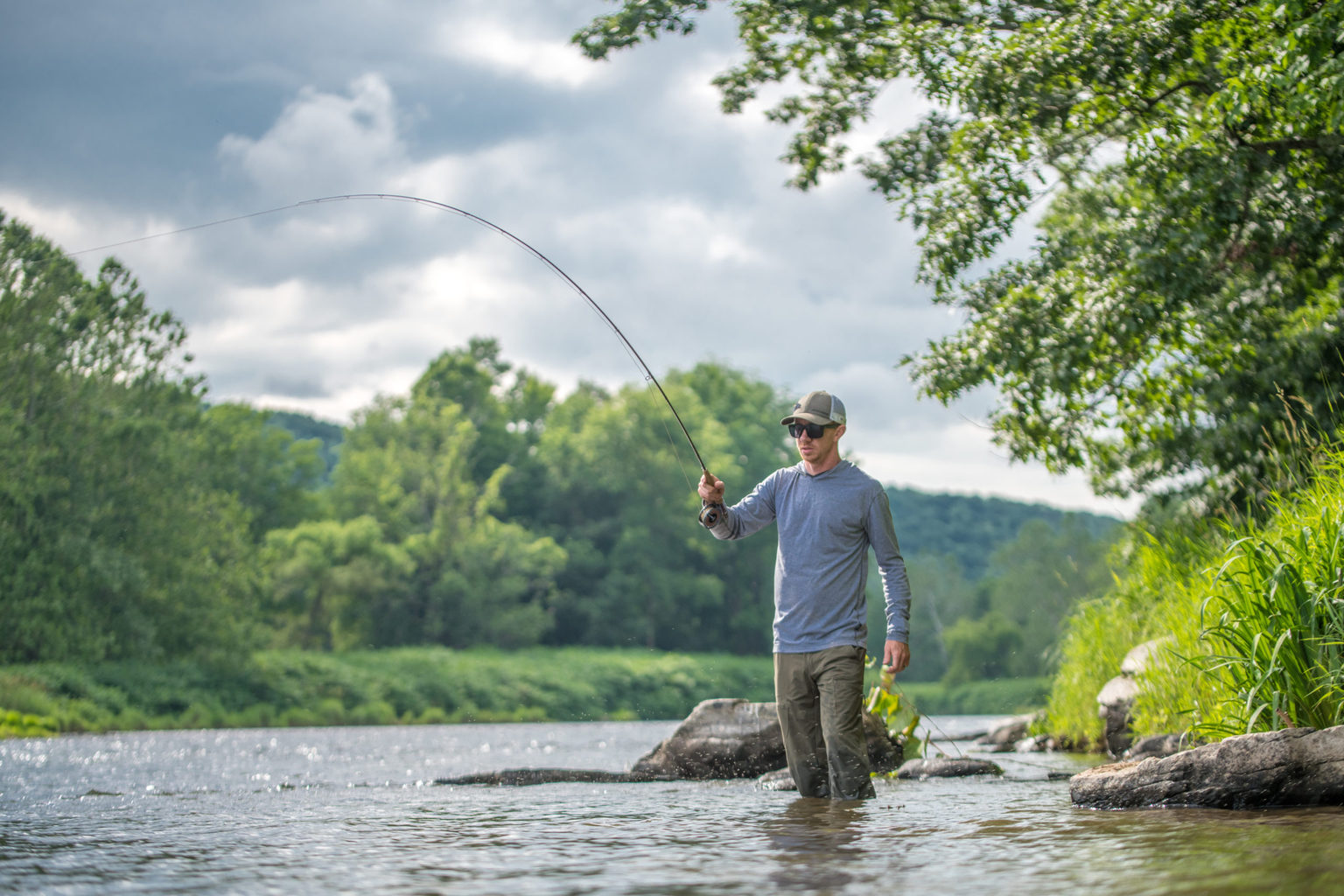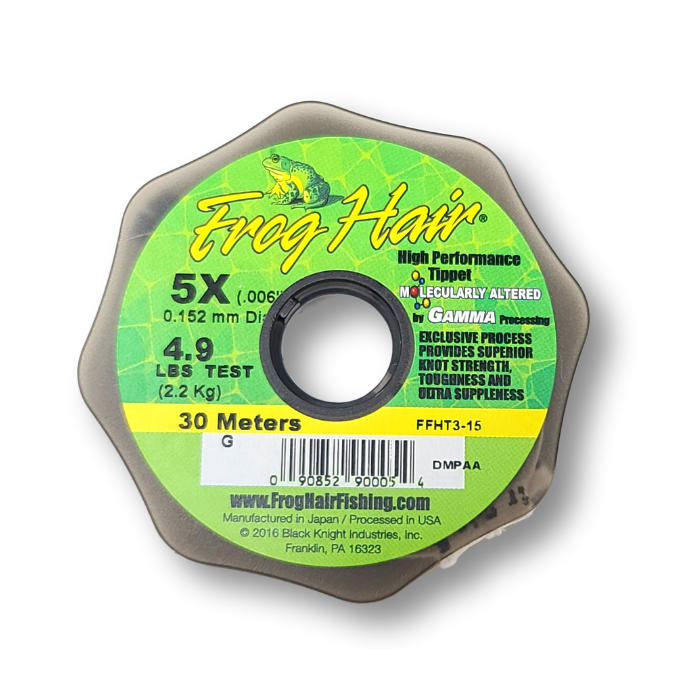

Of all the aspects of fly fishing that intimidate anglers, choosing the right line and knowing when to use it perhaps stands above all others. So here’s a quick guide to choosing the correct size fly fishing tippet and leader.
Table Of Contents


Tippet is a type of fly fishing line that is consistently the same weight, poundage, and diameter throughout the entire line with the purpose of being used in snippets. Every time you change a fly and snip the excess off, you are losing more length on your line – simple concept. After a load of snagging trees, catching fish, and changing flies, your line becomes rather short. An easy way to add more length is to attach a section of fly fishing tippet.


Fly fishing leaders are a tapered section of line for the use of tying on fly fishing flies that is directly attached to your thick, colored fly line by either a loop-to-loop connection or knot. Fly leaders can be hand-woven, hand-tied, or mechanically made but are always tapered having one end thicker than the other. Leaders have this taper for a reason: to transfer the momentum and energy from the rod to the fly during casting. Usually, you’ll find leaders in lengths of 7.5-ft, 9-ft, or 12-ft for anglers who fish in varying conditions with 9-ft as the standard.
Changing flies means clipping the thinnest end of the line shorter and shorter. Leaders are tapered so that means with every clip you get closer and closer to the thickest part of the leader.
Leaders wear down after extended periods of use and become ineffectively short, thick, and stubby. More often than not, you’ll find your leader too thick to tie a solid knot with.
You may think, “if only I could add more thin line right onto this leader — I could continue to use the leader and keep fishing.” Rather than unpackaging a new leader and taking the time to replace the old one, it may be easier to cut off a section of thinner tippet from the spool and tie it onto your existing leader. Within just a few minutes you can tie on a few feet of tippet and manually craft your own tapered leader and keep fishing.
There are 2 main types of tippet that are categorized by the material used in each. The first is Monofilament, which is generalized by lower poundage, lower prices, and a diverse range of uses for most species. The second is Fuolorcarbon, which is typically stronger, more expensive, and is reserved for occasions that require a more durable line.
Monofilament is the most commonly used in fly rigs. Think of it as the “go-to”, the fly line you use in every situation.
Take care not to leave monofilament out in direct sunlight as UV rays will deteriorate it. I would suggest that before each fishing trip, take a few moments to inspect your line for any kinks, knots, and cuts that seem to compromise the strength of the line. Even more surprisingly, much like humans tippet can even become bruised. This is usually when it takes a beating against rocks and turns the areas a foggy white.
Knowing when to use 6X tippet instead of 4X or a 7.5 ft leader rather than a 9 ft confounds anglers of all skill levels, and unfortunately, some of our catching woes can be attributed to the line we are using. Here are a few things to consider when deciding what size tippet and leader you should be using.
Knowing what size to pair with your flies is just as important as your fly selection. The thickness of your tippet and leader can make or, quite literally, break the quality of your presentation. For reference on how diameter and size affect tippet strength, here’s a great article.
Thicker tippet and leader sizes (0X – 3X) are stiff enough to roll over and cast heavier flies with greater accuracy. Not only that, but bigger flies usually mean larger fish so these thicker tippets will provide higher poundage to avoid losing your personal best catch to a weak knot. Use 3X or thicker tippet for any flies as large or bigger than a size #8. This includes streamers, poppers, and bass bugs or casting to large fish.
I would not recommend using these large sizes for tiny flies simply because their thickness would prevent a natural drift. For example, casting tiny size #20 tricos on a slow-moving pool with a 2X tippet would not be able to dead-drift naturally were a 6X or 7X would shine.
Mid-Range tippets (4X – 5X) are ideal for small streamers and nymphing rigs. These sizes are not ideal for casting big flies and are best suited for flies smaller than #8. It’s not that 4X or 5X is too light of poundage to handle big fish, it’s simply that they may be a little too flimsy for curling heavy streamers easily.
Thinner tippet sizes (6X – 7X) are perfect for small flies and delicate casts. When casting to rising trout requires a soft presentation to avoid spooking them, use these thinner sizes. The fineness of these tippets allows your rigs to drift naturally with the microcurrents and float gently onto the water without disrupting any active feeding.
For the catch and release angler, making responsible decisions starts with the size of the line used. Sure, big fish can be landed on 6X and 7X tippet, but at a cost to be sure. A lighter line means longer fights and more stressed out fish, so the size of tippet and leader should be determined somewhat by the fish being sought after.
The smaller the number, the thicker the leader. Thicker leaders are designed to cast heavier flies and catch bigger fish. Pair all sizes with 2-7 weight rods for optimal performance.
1x – 3x: Great for large predator fish like bass, large trout, carp, and steelhead. These weights are meant to fight bigger fish and cast larger, heavier flies such as articulated streamers or weighted nymphs with ease.
4x – 6x: Perfect for casting smaller streamers, wet flies, nymphs, and dry flies. These are lighter weight lines for more delicate and precise presentations.
You can any tippet as thick as 0X or as thin as 7X for trout fly fishing. If it fits through the eye of the hook, you can fish it. But, there are certain situations that call for thick tippets and ones where thin tippets are ideal. With that being said, the honest truth is that there are no rules to selecting tippet size so it is largely up to your personal preference.
Here’s a guide guide to selecting your tippet size for trout:
6X – 7X are ideal for soft presentations of dry flies ranging from a size #12 to #22 or smaller hook. The poundage on these tippets is lower and therefore requires a more tactful approach to landing big fish.
4X – 5X are extremely versatile and can be used for anything from small streamers and nymphs to casting all sizes of dry flies. You can easily cast flies ranging from size #8 to size #22. We also recommend using 4X or 5X as your tag ends or trailing sections for multi-fly rigs as they are stiff enough to reduce tangles.
0X – 3X is perfect for slinging heavy streamers or bulky nymphing rigs to hefty trout. These sizes are great for the butt-sections of your custom leaders or re-building an old rig.
Steelhead are a type of trout and require much thicker tippet due to their mass and speed. I would not recommend going any smaller than a 3X tippet for steelhead and only advise using 0X, 1X, 2X, or 3X tippet.

Fly Fishing Made Easy 👍
Our Quarterly Fly Club ships 1,000’s of flies to anglers all across the United States. Receive curated fly assortments selected for the season with in-depth articles on how to fish them. Great for beginners to learn and for intermediates to discover new flies.
You’ll hook more steelhead using 6X tippet in low and clear water, but the fight needed to land a fish will undoubtedly raise the mortality rate of a caught fish. For trout less than 20 inches, leader and tippet sizes don’t matter as much for fish safety as they do landing rate of hooked fish. Therein lies the difference in fish targeted to line size to be used. Bigger fish means heavier tippet in the name of conservation!
On a typical day of trout fishing, anglers might cycle from streamers to dries to nymphs, all in the same spot! Now, we know things like adjusting weight and indicator depth to match the difference in flies, but our line size should be adjusted as well. A streamer on 6X is just asking for break-offs when even a modest fish crushes a wooly bugger and results in a firm strip-set.
The flip side of this is tossing tiny dry flies that need to land with hardly a ripple so as to not spook any unsuspecting feeding trout.
In this situation of using tiny dry flies, a lighter leader and tippet is needed not only for the delicate presentation but also to properly thread through the hook eye. A #24 Trico is physically unable to accommodate 4X line because of how small the eye is, and even if it does thread through, the knot will be just as large as the fly itself, threatening to screw up our drift!

The iconic Montana spring creeks that constantly adorn fly fishing magazines are as iconic as they are challenging. Part of what makes them such a challenge is the incredibly slow current that requires long casts and creeping approaches. It’s in these waters that 7X tippet is the name of the game if one wants to have even the slightest chance at a fish! Drive just a few minutes away and the tumbling mountain freestone streams that feature pocket water havens allow for a thicker line.
Faster water where trout have less time to inspect our line and flies, allow for a thicker line that won’t hurt our hookup chances while increasing our landing rate. It’s the same thought process that allows us to use a size #10 stonefly instead of the #14 that more properly imitates the natural bugs in the waterway.
That’s the name of the game when deciding on line sizes: figuring out the equation of what can responsibly land fish based on the type of flies being used, and in what kind of water. This will eventually become second nature and not only keep the fish safe but result in dripping wet nets and happy fishers!
The short answer is, yes , trout see tippet and fly leaders. Trout have very good eyesight and can spot the line indentation within the surface and drifting through the water.
The real question is does it truly matter? In certain sections of streams, it does seem to help to use thinner tippet and leader. However, I strongly believe that trout don’t care. I think it comes down to how natural-looking the presentation of your fly is. Thinner leader and tippet move more naturally in the water due to their lack of stiffness, which makes your fly fishing flies drift downstream unimpeded like the real thing.

Fly Fishing Made Easy 👍
Our Quarterly Fly Club ships 1,000’s of flies to anglers all across the United States. Receive curated fly assortments selected for the season with in-depth articles on how to fish them. Great for beginners to learn and for intermediates to discover new flies.